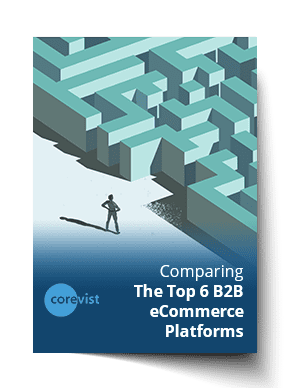Share
Author
George Anderson
Share
Industrial manufacturers have many options when it comes to eCommerce platforms. Many of these solutions were originally designed for B2C, which means their offerings don’t always align with the needs of industrial organizations.
How can you zero in on what matters most for industrial eCommerce?
There’s one key question that should guide your path in industrial eCommerce. In this article, we’ll talk about that question and its implications.
The question: How much SAP ERP integration do you need?
At a high level, there are only two ways to answer this question. We’ll unpack each situation below.
Minimal SAP ERP integration required. If all your transactions are generic, meaning you have no customer-specific or product-specific business rules, and you don’t need real-time order tracking or account management, then you may not need deep ERP integration. In this situation, your industrial eCommerce use case is actually very similar to B2C, which means you can use a conventional eCommerce platform with batch synchronization between the web store and SAP.
Click to jump: More on minimal SAP integration
Deep SAP integration required. If each customer’s transactions are personalized with unique business rules (such as contract pricing, personalized inventory availability, personalized catalogs, or unique SKU permissions), or if you need real-time order tracking and account management capabilities, then you have a true B2B use case. In this situation, a conventional platform with middleware may be more trouble than it’s worth. You’ll need an industrial eCommerce solution that puts your SAP system at the core. (Hint: This is the Corevist approach.)
Click to jump: More on deep SAP integration
What to look for if you need minimal SAP integration
If your transactions aren’t governed by complex business rules, you can look at conventional eCommerce platforms like Magento, Shopify or BigCommerce. While these weren’t built specifically for industrial eCommerce, their B2C origin means they adapt well to scenarios with generic transactions. If you need rudimentary data transfer between eCommerce and SAP, a platform like this with a middleware integration may be adequate.
So which conventional platform should you choose?
They all differ in terms of cost and the responsibility that your organization will take on.
Since overall revenue often correlates with depth of available resources, we recommend using your company’s revenue to determine which platform is right for you. Download our FREE platform comparison chart to start narrowing down your choices for industrial eCommerce.
FREE Chart
Compare Top 6 B2B Platforms
Find your best fit based on revenue size, complexity, and depth of SAP integration required. Compare SAP Commerce Cloud, Salesforce B2B Commerce, and more.
What to look for if you need deep SAP integration
If you need deep SAP integration in your industrial eCommerce solution, it’s hard to tell if a conventional platform will meet your needs. In marketing materials, you’ll see a lot about look and feel, branding, merchandising capabilities and mobile friendliness.
While all these are important (particularly mobile), industrial manufacturers typically have far more basic needs that conventional platforms don’t address.
Here are three key considerations as you evaluate industrial eCommerce solutions.
1. The platform should offer accurate customer personalization through SAP integration
Think about your current ordering processes (assuming you don’t already have an industrial eCommerce solution). Whether customers order by phone, fax, email or EDI, each transaction is controlled by SAP logic and data.
For example, when a customer calls in to place an order, their interaction with customer service is governed entirely by SAP. Unless your business processes live in sticky notes and tribal knowledge (which is not a good setup), the ERP will determine everything about the transaction. Here are some data points and customer interactions that typically require SAP determination.
- Personalized picklist that the customer can buy from, if applicable.
- Real-time stock availability (including personalized ATP, or available to promise, if relevant at your organization).
- Real-time pricing based on the customer’s contract as well as any bundled or scaled pricing rules.
- Available RDD (requested delivery dates) that the customer can choose from.
- Choice of ship-from warehouse for faster or cheaper shipping.
- Assignment of sold-to and payer account, if your customers (or sales reps) place orders on behalf of multiple entities.
This is just the beginning. Many industrial manufacturers have additional SAP data or interaction points that help shape their transactions.
This is why industrial manufacturers typically need an eCommerce platform (like Corevist Commerce) that’s built on a deep SAP integration. Without that integration at the core, industrial eCommerce is simply too expensive, complex and risky for many manufacturers to handle.
2. The platform shouldn’t create more work for IT (or require lots of outsourced help)
This point is directly tied to the previous. If you choose an industrial eCommerce platform that isn’t built on a comprehensive SAP integration, you’ll create more work for IT.
Just how much work?
Consider this.
You’ll need middleware. You’ll need eCommerce. And you’ll still have to maintain your SAP ERP data. Suddenly, you’ve got three times the data maintenance you had before. Since you’ll have to duplicate all your SAP business logic in middleware and eCommerce, you’ve also got two additional systems where something can go wrong.
While outsourcing those two additional systems may look cheaper, it also introduces difficulties in keeping all parties in sync (and all systems working together smoothly). That’s a risky proposition for midmarket manufacturers looking to launch industrial eCommerce.
3. The platform should scale up easily without duplicate investment
Life at an industrial manufacturer is complex. You may have multiple sales areas, product lines, or geographical segments that each need their own unique front-end eCommerce treatment.
On the backend, you’ve got an SAP ERP system that defines and manages all those brands, geographies, customers and divisions. How do you bring all that complexity to the web without creating a nightmare?
Here’s where deep SAP integration shines again. For organizations that run on one centralized SAP system (or have templatized ERP instances that are configured similarly), a solution like Corevist Commerce is a great fit. You can reuse your initial investment in ERP integration architecture to launch multiple storefronts without duplicate investment.
This means you can bring all your brands, geographies and product lines to the web with the appropriate branding and user experience. In the backend, all these Corevist Commerce instances run on the same comprehensive SAP integration architecture.
Want to see deep SAP integration in industrial eCommerce?
Check out the Corevist Commerce demo video.
Real-time SAP data in a sleek, mobile-friendly UI that’s built for industrial use cases.











